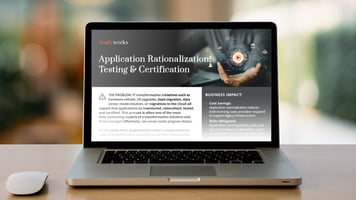Even as inflation remains high, CIOs are twice as likely to invest in new technologies rather than optimize their existing tech stack, according to a new study from Lenovo. But the majority are concerned they won’t have sufficient resources to invest effectively in innovation for their organization’s IT infrastructure.
As many companies implement formal hybrid working policies to retain key talent, IT will need to invest in new applications and devices to maintain user collaboration and productivity. But each new tech introduction brings with it a complex stack of interdependent components including operating systems, databases, programming languages, web servers and application frameworks.
Plans to adopt capabilities such as AI and analytics will accelerate cloud adoption for many businesses as well as the introduction of containers and microservices to support them, only serving to increase estate complexity. For CIOs to avoid risk and grow capabilities cost-effectively and efficiently, they must work with teams to tackle this now.
The risks of ignoring current IT estate complexity
With buying power eroded by rising costs, it’s clear from the research CIOs believe that something has to give. They have high expectations for digital transformation, but by neglecting current estate complexity they’ll invite risk and impede new tech introduction:
- 51% of CIOs expect tech vendors to help them improve organizational agility according to the Lenovo study, but adding new tech to support teams without optimizing the existing infrastructure could mean roadblocks to introduction. With myriad interdependencies, any change could be risky, requiring, at the least, skilled expertise to create workarounds that take time to implement. At a time when competition for tech expertise is rife, do you want to tie up your key developers with managing workarounds and troubleshooting?
- 44% of CIOs want tech investments to help secure systems and operations. But new tech, including third-party devices and applications, will only increase the potential for system vulnerabilities and cyberattacks. Without clear visibility across the estate, how can your teams effectively manage numerous vendor schedules of updates and patches? Statista forecasts that between 2023 and 2028, the global estimated cost of cybercrime will increase by $5.7 trillion. Can your enterprise risk eyewatering fines, and loss of productivity or reputation?
- Tech maintenance and configuration is another priority for CIOs, with 41% expecting tasks to be simplified by new tech investments. However, with a growing number of disparate components making up the estate, managing updates and patching is going to become even more cumbersome. If these are ignored, in favor of new tech integration, productivity and data could be at risk. Cost optimization will also be impossible, and the 38% of CIOs that expect to achieve that through digital initiatives will be disappointed as managing increased complexity or troubleshooting errors continue to devour team time.
- Delays to new service introduction, disruptions to critical services, and increased system vulnerability are going to impact the user and customer experience. Disruptions and data breaches will see key talent and customers going elsewhere.
- ESG goals and regulatory compliance will fall by the wayside if teams don’t have clear visibility across the current and future tech stack to measure progress against goals.
It’s clear that if current tech stack complexity isn’t prioritized, CIOs will not be able to reap the true value of new digital investments, teams will be focused on firefighting and data will be put at risk.
Best practices to address tech debt and enable business transformation
A new Unisys study indicates the next wave of digital transformation can only be achieved by prioritizing cloud investments, aligning priorities across the business, addressing skills gaps and focusing on resilience. So how best can CIOs address current estate complexity while prioritizing investments and aligning the business for growth?
- Focus on new tech that offers the greatest value across the business. Build cross-business communications channels to identify the big picture need and spread costs and rewards.
- Gain real-time estate transparency to identify obsolete technology, possibilities for aggregation, interdependencies within your current IT estate, and synergies with new technology investments to understand how existing tech stacks can be leveraged to support new technology integrations, thereby limiting spend, and additional complexity.
- Find ways to retain knowledge about the existing estate, while implementing tools that allow employees to be retrained/upskilled at scale to assist new tech introduction and adoption.
Automate Application Rationalization to Free Budgets for Digital Transformation Initiatives.
DOWNLOAD THE SOLUTION BRIEFAs business teams prioritize digitalization, accessing operational data to optimize processes, IT won’t be able to support their needs effectively leveraging manual processes. Growing tech stack complexity and dwindling team numbers will mean the need to redirect key expertise to work on monotonous, manual administrative tasks, rather than focusing on the initiatives to drive growth.
Consequently, CIOs should focus on adopting automation and Gartner agrees, suggesting that IT is closing the skills gap by investing in automation to drive growth at scale with fewer employees. And, as more CIOs are being asked to optimize operations beyond IT, they should adopt automation in a way that allows them to get the best value of their existing IT estate and new tech to meet the needs of teams around the business.
By talking to their IT teams, CIOs will have a better understanding of the risks that leveraging manual processes in a digital world will have on the business as well as the time and effort that it takes to manage them. Then by equipping those teams for change using intelligent automation, they can drive true business value, ensuring IT leads the way in tackling cross-business initiatives.
Optimize your tech stacks using a digital platform conductor
One way of leveraging automation to tackle tech stack complexity and to get the best from digital transformation investments is to implement a digital platform conductor (DPC), a tool cited as transformational in five Gartner Hype Cycles.
A DPC enables this by connecting to all the tools, repositories, and databases required to manage existing and new capabilities and aggregating, normalizing, and analyzing the data they contain. This affords teams an accurate, real-time view of their data from any angle or interdependent component. Using this, they can identify redundancies and synergies between existing and new tech to plot a clear path to remove tech stack complexity. Then, relying on a DPC’s orchestration capabilities they can automate change when the estate is ready and risks are removed, to achieve business digital transformation goals.
Book a demo with ReadyWorks to see how a digital platform conductor will help to reduce tech stack complexity even as you implement new technology for business transformation.

